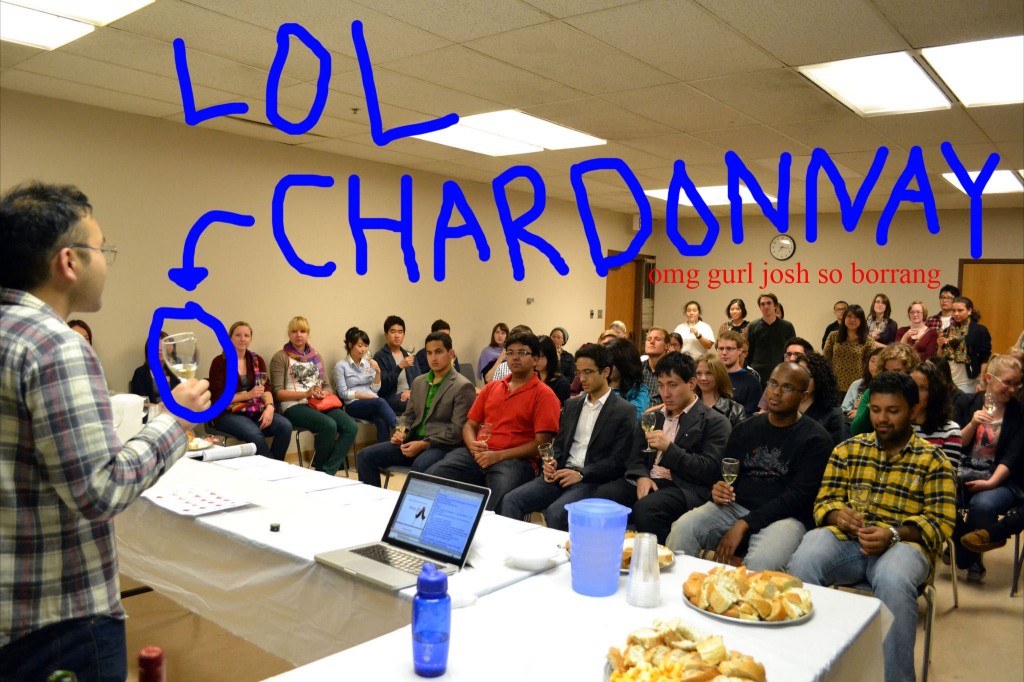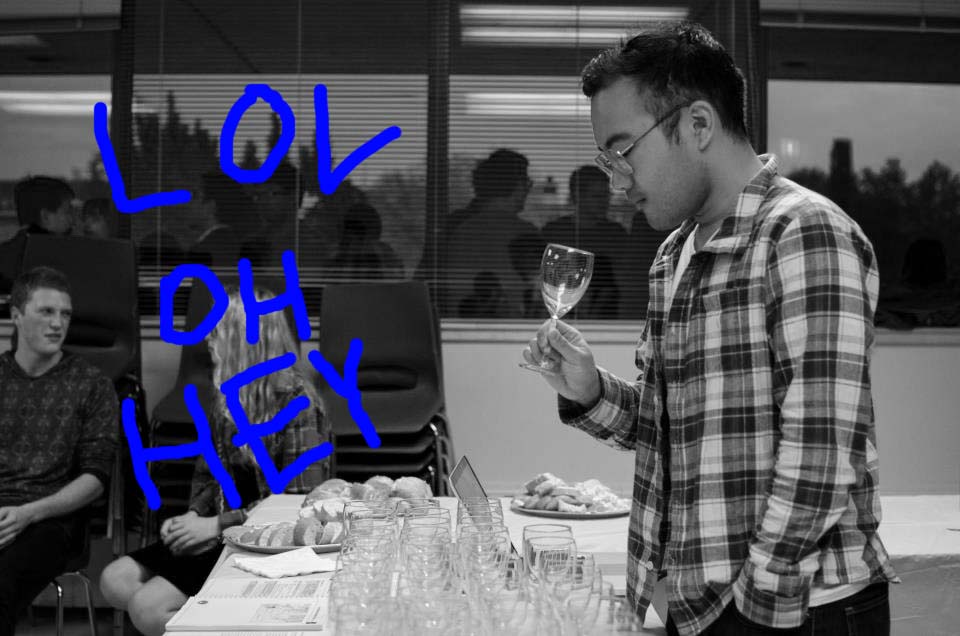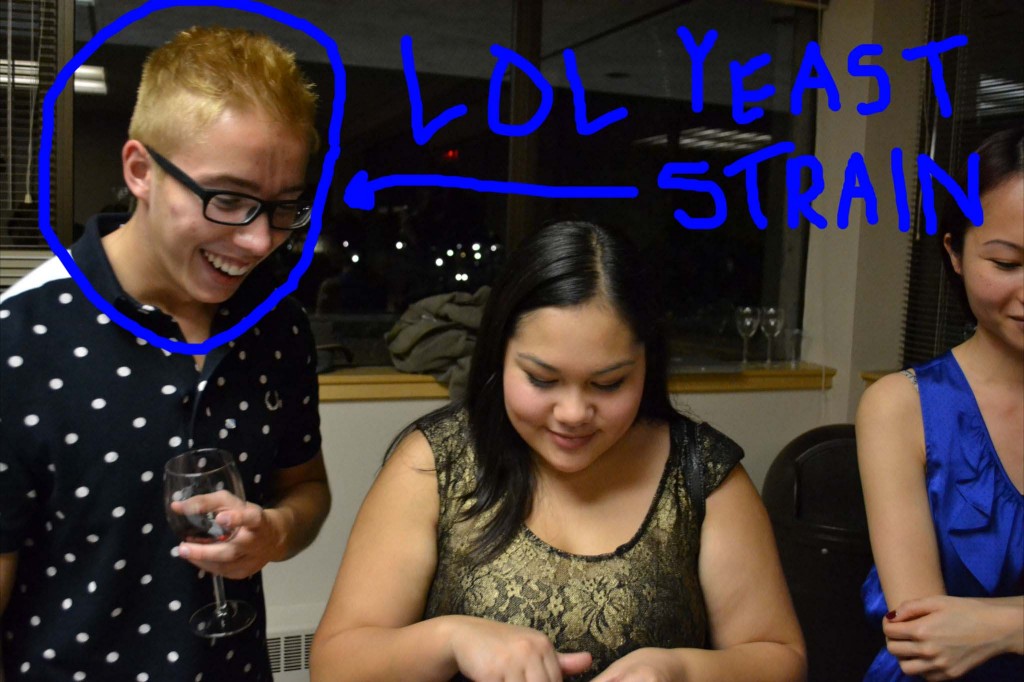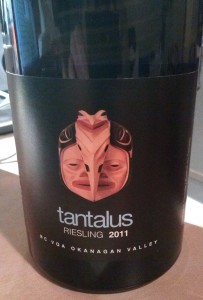So yeah! I led the first tasting of this school year at the UBC Wine Tasting Club. It was awesome and complete with me spilling wine while demonstrating swirling, me speaking horrendously quietly and fast while avoiding the tens and tens of eyes on me, and me silently freaking out and wondering if people were getting bored as I barked on and on about the noble grape varieties. Which is great, because that’s me being normal.
Okay, maybe I’m exaggerating.
What was also fantastic was that Holly brought her Le Nez du Vin set which was amazingly fun. People were trying to quiz each other with smells or just smelled the little vials in general. My favourite picture was the one with the goat-looking beast with weird fangs (“Musk”). And then there was that weird vial that smelled so much like that odd and off basement-smell of the SUB (“Hawthorne?”). But anyways yeah that was fun.
So: we tasted a Chardonnay, a Riesling, a Pinot Noir, and a Bordeaux blend. Perhaps this Friday we’ll fill in the rest of the noble grapes with Sauvignon Blanc, Syrah, and maybe a bunch of other fun things.
More specifically:
1) Robin Ridge Chardonnay (BC)
Temporarily no picture! Anywho, this Chardonnay was just lightly to medium-ly oaked. I almost chose a superoaked Californian Chardonnay but wasn’t sure if many people were into that, so I tried to pick something middle of the road. Very medium everything, in terms of aromatic intensity, acid, length, and weight (med+). Had some of that butteriness and smoky popcorn quality which was cool. Definitely a nice comfort wine – and totally characterful without bridging into that Californian identity. Around 20 dollars!
2) 2008 Ayler Kupp Riesling Spätlese (Germany) OR 2011 Tantalus Riesling (BC)
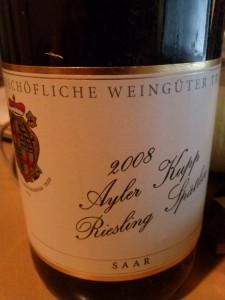 So I bought two of the Spätlesen in the summer, since they were only 25 dollars: apparently there was a different vintage that was twice the price, so what the heck? After a while I decided to save it for the club, since Spätlesen are a nice little treat. I was also looking forward to the Tantalus Riesling. VERY well known producer here in BC, and it set up a nice little contrast to the German one we had. The German one was sweeter and had more stone fruit – although it was juicy, it was also slightly lower in acid (probably due to age) and I wouldn’t age it longer than a couple of years or so. The Tantalus was definitely brighter – more green and citrus, higher in acidity. Both had a hint of petrol but perhaps that was just the power of suggestion. Both nice, and the Tantalus could age without a doubt.
So I bought two of the Spätlesen in the summer, since they were only 25 dollars: apparently there was a different vintage that was twice the price, so what the heck? After a while I decided to save it for the club, since Spätlesen are a nice little treat. I was also looking forward to the Tantalus Riesling. VERY well known producer here in BC, and it set up a nice little contrast to the German one we had. The German one was sweeter and had more stone fruit – although it was juicy, it was also slightly lower in acid (probably due to age) and I wouldn’t age it longer than a couple of years or so. The Tantalus was definitely brighter – more green and citrus, higher in acidity. Both had a hint of petrol but perhaps that was just the power of suggestion. Both nice, and the Tantalus could age without a doubt.
3) 2010 Quintay Clava Pinot Noir (Chile)
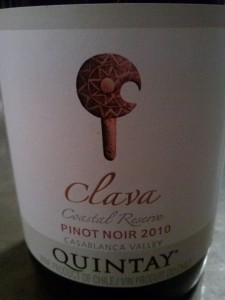 I’ve had this Pinot described as “poopy” (Rabbit in particular) to me but I didn’t think it was that poopy. For a Pinot Noir this was a bit on the heavier-bodied side – let’s say medium minus – and it was quite aromatic with red fruits (raspberries) and earth, with that slight ripe animal poopiness. Super cool for 22 bones. And, although it was a bit on the heavier side, it was still a nice shade of pale ruby. Would definitely recommend to people who like Pinot, as it bridges the New and Old World styles. I wouldn’t age this though – doesn’t have either the tannin or the acidity to do so – it’s fine as it is, anyways. Drink up!
I’ve had this Pinot described as “poopy” (Rabbit in particular) to me but I didn’t think it was that poopy. For a Pinot Noir this was a bit on the heavier-bodied side – let’s say medium minus – and it was quite aromatic with red fruits (raspberries) and earth, with that slight ripe animal poopiness. Super cool for 22 bones. And, although it was a bit on the heavier side, it was still a nice shade of pale ruby. Would definitely recommend to people who like Pinot, as it bridges the New and Old World styles. I wouldn’t age this though – doesn’t have either the tannin or the acidity to do so – it’s fine as it is, anyways. Drink up!
But yeah – Chile has great value. Having an ideal area for growing grapes, they also are surrounded by water, mountains, the cold, and so on – such that it’s hard for Phylloxera to ruin their vineyards. I’m thinking that means they can spend more time putting energy and money into taking care of their grapes and honing their winemaking skills instead of grafting their vines.
4) 2009 Château Rousselle Cru Bourgeois Côtes de Bourg (France)
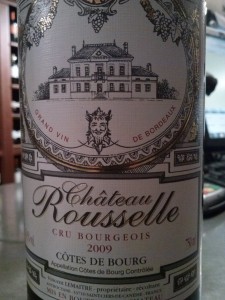 By the time we were pouring this wine I wasn’t even paying attention anymore. This was good. Medium to medium+ bodied, great balance, and very varietally correct, being mostly Merlot. 30 dollars might be a bit of a stretch for someone like a student, but it’s nice knowing that there are affordable bottles of Bordeaux that deliver seeing as affordable Bordeaux can be a bit of a hit-and-miss. Also, 2009 was a good year for Bordeaux – typically, vintages matter in places like France where moody climate can drastically change the quality of wines in a year. For places like Chile, vintages aren’t much but an indication of age.
By the time we were pouring this wine I wasn’t even paying attention anymore. This was good. Medium to medium+ bodied, great balance, and very varietally correct, being mostly Merlot. 30 dollars might be a bit of a stretch for someone like a student, but it’s nice knowing that there are affordable bottles of Bordeaux that deliver seeing as affordable Bordeaux can be a bit of a hit-and-miss. Also, 2009 was a good year for Bordeaux – typically, vintages matter in places like France where moody climate can drastically change the quality of wines in a year. For places like Chile, vintages aren’t much but an indication of age.
Oh. I also wrote these dorky write-ups on the grapes we tasted, like a silly Cliffnotes for noble grape varieties. I like to attribute grapes to personalities (as did my WSET instructor) – which is I guess similar to how you might mnemonically remember a list of mental diseases by attributing them to your group of friends, or, like, ROY G BIV. Yeah.
Chardonnay – The Chill One/The Joey Tribbiani/The Floater
Chardonnay is sort of like that person in your group who goes with the flow.
“What do you want to eat for lunch? Pizza? Sushi?”
“I don’t know, man, whatever you guys want to do.”
Being a non-aromatic grape variety, Chardonnay is essentially a slave to the winemaker, climate, and terroir. Almost literally grown in almost every region that wine grapes are grown, Chardonnay can be quite steely, acidic, and light in areas like Chablis (northern France), can be more sont fruit-like and mellow in the Cote d’Or (Burgundy), and can also take on dramatically different buttery and nutty characteristics in regions such as California. Chardonnay is also one of those grapes that can also handle oak treatment and malolactic fermentation. And, except for cool regions like Chablis or Champagne, Chardonnay is typically heavier in body compared to other grapes. Chardonnay can be a party animal as well – in the Champagne region of France, where Chardonnay arguably has the lightest and most austere expression, adding acidity and freshness.
Riesling – The Preppy One/The Leader/The MVP
Riesling is the king of the white grape varieties – it’s sort of like that popular superstar in high school everyone simultaneously loves and hates. Despite the currently decreasing trendiness of Riesling, this particular grape variety happens to be a sommelier’s dream. Its naturally high acidity makes it a very versatile food pairing wine, and its pronounced and fruity character may perhaps pair well with those who are new to this delicious liquid. Like Chardonnay, Riesling can be made in various styles, and more specifically, in sweetness: Riesling can be made in completely bone dry to amazingly sweet styles. In Germany, where Old World Riesling makes its name, grapes may be late harvested, with the grapes gaining concentration. In several regions, notably Germany and Australia – and, well-aged Riesling, in general, may interestingly enough, gain chemical aromas reminiscent of smoke or petrol caused by the compound 1,1,6-trimethyl-1,2-dihydronaphthalene.
Pinot Noir – The Perfectionist/The Hipster/The Artist
Pinot Noir is a silent perfectionist. This elegant grape variety typically tastes as hipster and feminine as it sounds, but quite difficult to cultivate because of its fussy and high-maintenance nature. The red berry expression of this grape is expressed well in pockets of cool climates – any hotter, and the interesting secondary characteristics are overtaken by overfruity jamminess. With age and the right terroir, Pinot Noir gains hauntingly interesting earthy and barnyard aromas, although because of its requirement for specific climate, most of the Pinot Noir produced is best consumed young. Pinot Noir is typically light in body, low in tannins, and relatively higher in acidity, also making it one of the most versatile food pairing wines. Despite its seemingly mysterious nature, Pinor Noir is one of the ingredients in Champagne (along with its cousin Pinot Meunier and Chardonnay) to add fruitiness and backbone.
Cabernet Sauvignon – The Jock/The Husband/The James Bond
Merlot – The Smooth One/The Wife/The Marilyn Monroe
Cabernet Sauvignon and Merlot are classic partners in crime, comedy duos, or friendly partners – think Jake and Amir, Harold and Kumar, Fred Flintstone and Barney Rubble, or Ted Mosby and Barney Stinson. Although they are typically blended in Bordeaux (southwestern France), they are popularly blended together in other regions as well, because they each offer a characteristic the other grape does not have. Cabernet Sauvignon is the more serious and masculine grape of the two: it is typically full-bodied, high to medium in acid, high in tannins, has an affinity for oak, and needs lots of sun to ripen properly. Having black fruit flavours, Cabernet Sauvignon can also gain secondary aroma characteristics of cedar, cigarbox, and other earthy aromas. Merlot, on the other hand, doesn’t need as much sun to ripen, and is commonly blended with Cabernet Sauvignon to soften it out. Merlot typically has a red/black fruity lushness on the midpalate. Silky and voluptuous, Merlot is lower in acid and tannin than Cabernet Sauvignon, and gains chocolate and fruitcake characteristcs with age. Cab Sauv is often called a “donut wine” – offering structure, but lacking the lush middle that Merlot can offer.
[Also thanks to Marissa and Matthew for the event pictures 🙂 I WOULD ruin and draw all over them.]
